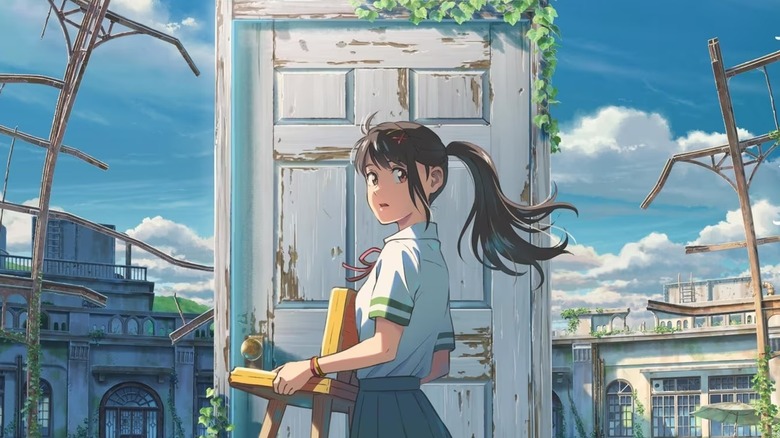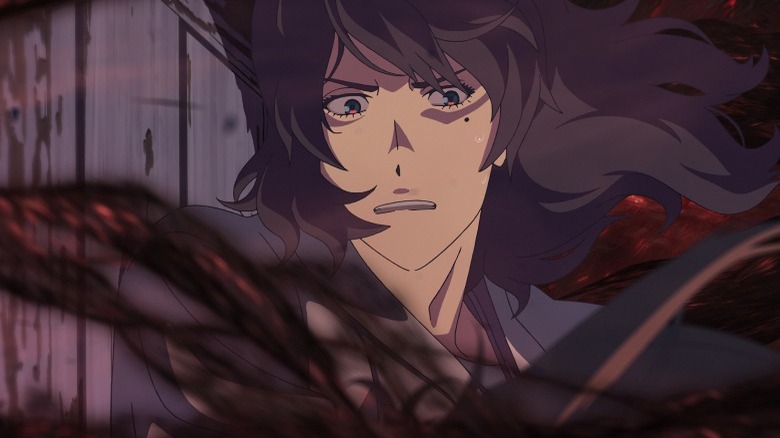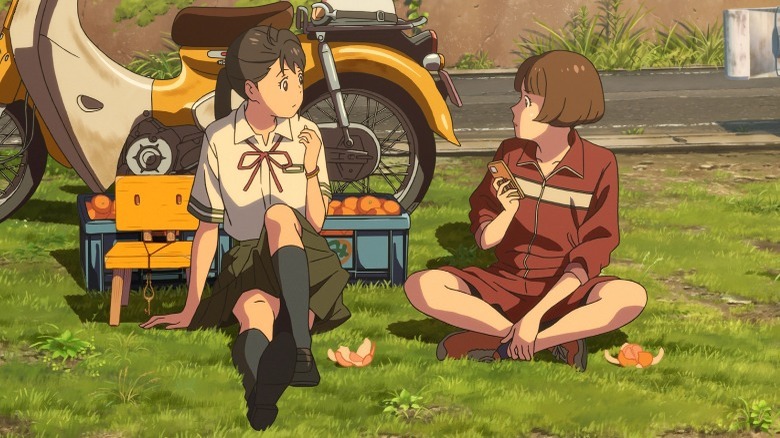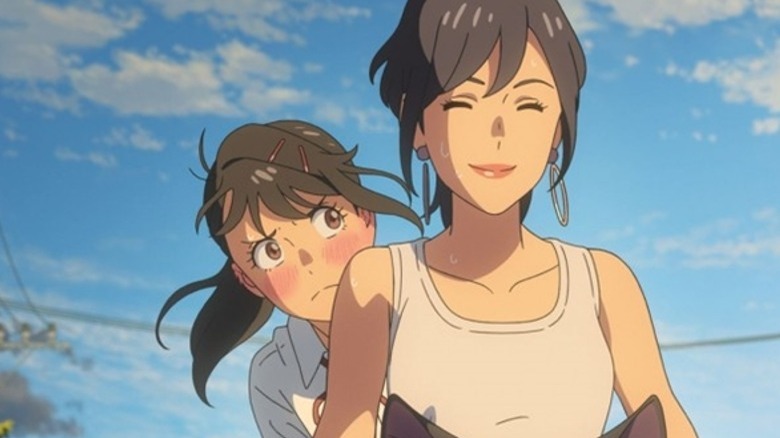
This post contains spoilers for Makoto Shinkai's "Suzume."
Makoto Shinkai's strengths as an animator lie in his ability to mesh vividly beautiful visuals with thoughtful fantastical narratives, where the mundane and magical come together to tell emotionally-resonant stories. Shinkai's highly acclaimed "Your Name" underlines this thread of wonder that is ever-present in his work, as it delves into a mystical, inexplicable connection between two teenagers, whose love for one another is rooted in the spiritual. Shinkai's latest, dazzling entry in his impressive oeuvre, "Suzume," follows a similar format, where the love shared between Suzume (Nanoka Hara) and Sōta (Hokuto Matsumura) is eclipsed by a need to return to the self and honor the past to make way for the future.
Shinkai's art style and narrative prowess have often been compared to legendary animator Hayao Miyazaki and the artistic identity of Studio Ghibli as a whole — and for good reason. Both artists etch the everyday beauties and terrors of existence in minute, profound detail while rooting their stories in human connections that often defy logical explanations. There is an unbridled celebration of the human imagination in Miyazaki and Shinkai's works, where the absurdity of the supernatural weave in seamlessly with the groundedness of human emotions, so much so that the simplest acts of love helps unlock generational curses or prevent an impending catastrophe.
Miyazaki's influence on Shinkai's journey as an artist is undeniable, and "Suzume" is the greatest example of a labor of love that pays homage to the DNA of Studio Ghibli movies while retaining its own unique identity. Shinkai's Studio Ghibli references in "Suzume" are intentional and overt; inanimate objects assume life, the lead embarks on a life-altering journey, and the true magic in a fantastical setting lies in the mundane experiences that lead to a mystical destination.
The Real And The Fantastical Mingle

What makes "Suzume" different from Makoto Shinkai's previous works is its incorporation of the real-life Tōhoku earthquake and tsunami disaster in Japan, which is used to capture the anxiety of living in a high-intensity earthquake-prone zone and the disastrous aftermath of such a tragedy. Suzume is suddenly thrust into the role of protector after she accidentally dislodges a keystone meant to entrap an otherworldly worm. Even before Suzume embarks on a journey to save humanity, we are privy to the reality of constantly living on the edge: cell phones go off every once in a while to provide earthquake alerts, disrupting the calm hum-drum of everyday life.
Hayao Miyazaki, and Studio Ghibli in general, routinely incorporate real-life tragedies in their animated narratives. Ghibli's "Grave of the Fireflies" is perhaps one of the greatest anti-war films of all time, as it tells the tragic story of two siblings during World War II. Similarly, Miyazaki's "Howl's Moving Castle" uses war less as a backdrop and more as an active component of the story, functioning as a critique of the Iraq War and the disastrous consequences of military conflict that impacts civilian life on a massive scale.
Shinkai employs the Tōhoku tragedy in "Suzume" to a similar effect by taking a fantastical approach to the event, where Sōta and Suzume must race against time to prevent a similar catastrophe from occurring again. There's a mystical explanation as to why these earthquakes occur, and personal sacrifice is necessary to prevent the world from ending. "Suzume" also pays homage to Miyazaki by imbuing the central character's journey with key lessons about grief and acceptance. This is done by crossing a threshold into the unknown, just like Sophie does to save Howl's heart in "Howl's Moving Castle."
Love In The Form Of Earnest Homage

Beyond the Ghibli influences, "Suzume" deliberately packs some of its frames with Easter eggs from Hayao Miyazaki's films, such as callbacks to "Kiki's Delivery Service" with Daijin, the talking cat, and the music that plays during the final car ride in the film. Moreover, the battle that takes place between the ginormous worm and the two guardian spirits is reminiscent of imagery from "Spirited Away," while the rest of the film consciously mimics the aesthetic blueprint of Ghibli films with lush meadows, warm, home-cooked meals, and the profundity of human connection.
Perhaps the most effective mirroring of a Miyazaki film can be found in the parallels between Suzume and Sophie from "Howl's Moving Castle," as both characters must return to the past to contend with the future. Love plays a prominent role here; Sophie's love for Howl urges her to embrace him even when he's on the verge of losing himself, becoming more monstrous with each transformation, while Suzume's unwavering dedication to save Sōta at the expense of endangering the world is the ultimate act of defiance.
Self-acceptance is also a major theme here, just like Sophie acknowledging her beauty and resilience to find her place in the world, and Suzume's acknowledgment of unbearable loss and making peace with it as an adult. These are inner journeys that are essential for growth and tie in directly with the fates of the worlds they inhabit. Even the doorway that Suzume peers into overlooks a meadow of dreams, where time exists all at once, which is similar to the one Howl shows Sophie in a subtle demonstration of his love for her. In this meadow, dreams are nestled along with uncomfortable truths, and Suzume needs to accept these revelations in order to move on.
Shinkai's Suzume Shines On Its Own

While "Suzume" wears its Ghibli/Miyazaki references on its sleeve, Makoto Shinkai infuses the story with his own eccentricities that allow the film to stand on its own. This is evidenced in the scenes where Sōta turns into a three-legged chair, leading to extended segments of physical comedy that elevate the road-trip elements of the film. While inanimate talking objects are often a Ghibli specialty, Shinkai takes this idea further by reveling in the absurdity of the situation, using it beyond a running gag by allowing Sōta and Suzume to develop a meaningful bond in the process. Moreover, there's the way Shinkai lingers on the subtle charm of everyday events, which is expressed in bold, beautiful ways, such as intimate, personal moments of friendship unraveling at a languid, indulgent pace.
Shinkai seems to be in no rush to arrive at the mystical climax, which works in favor of this deeply-moving film. As a result, none of the big emotional moments towards the end feel forced, as everything is thoroughly earned via the small, lingering vignettes that the characters partake in, including conversations that are mired in a shared sense of desolation and longing. This accentuates the wonder inherent in the magical segments, where stunning imagery is used to convey the beauty and pathos of a world that lives between the sands of time.
What makes "Suzume" work for me is its use of the "one must journey back to their past self to save themselves" trope. Without making it feel heavy-handed, Shinkai succeeds in convincing us that Suzume is the one that saves herself, and grants her broken childhood self the hope and optimism required to move forward in life, which is ultimately worth loving for. What is more life-affirming than that?
Read this next: 10 Anime Movies That Deserved To Win The Oscar For Best Animated Feature
The post Makoto Shinkai's Suzume Is The Best Case Scenario Of Borrowing From Miyazaki And Studio Ghibli appeared first on /Film.
from /Film https://ift.tt/8oc4wFN


No comments:
Post a Comment